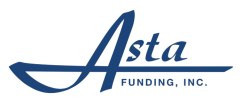|
|
LEGAL DISCLAIMER: This website has been prepared solely for the purpose of providing information about Asta Funding Inc. and the services and products it offers. This website has been compiled in good faith by Asta Funding Inc. However, no representation is made as to the completeness or accuracy of the information it contains. In particular, you should be aware that this information may be incomplete, may contain errors or may have become out of date. The reports filed by Asta Funding Inc with the Securities and Exchange Commission and listed on this website speak only as of the respective dates on which they are filed or used by Asta Funding Inc. The contents of those reports can become out-of-date. Asta Funding Inc makes no commitment, and disclaims any duty, to update any of those reports. Asta Funding Inc reserves the right to add, modify or delete any information at this website at any time. This publication and any references to products or services are provided "as is" without any warranty or implied term of any kind. Reproduction or distribution of any materials obtained on this website or linking to this website without written permission is prohibited.
Copyright ©2017 or earlier. Asta Funding, Inc. |
